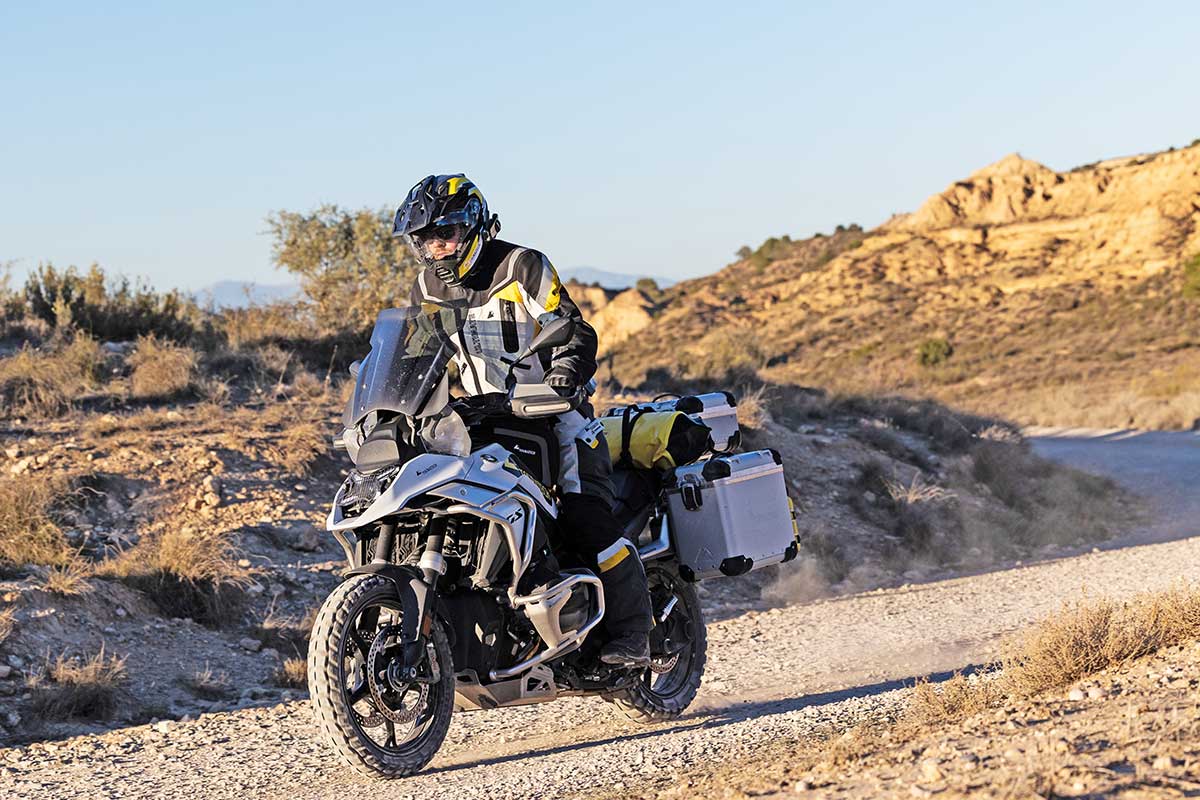Instead of simply increasing the engine displacement a little, BMW has completely remodelled the boxer. And not much has remained the same with the chassis either. Let's take a detailed look at the new BMW R 1300 GS.
Time and again, the development engineers at BMW are faced with the challenge of having to reinvent the boxer engine. And the intervals are getting shorter: four-valve engine in 1993, liquid cooling and vertical flow in 2012, variable valve timing in 2019, and now - in 2023 - a whole host of innovations again. The trick that the developers have to pull off with each new evolutionary stage is to bring the boxer up to the latest state of the art, without – God forbid! – distorting the basic character of the charismatic drive.
145 PS FROM EXACTLY 1.300 CUBIC CENTIMETRES
A small increase in cubic capacity was mandatory so as to not lose touch with the increasingly voluminous and powerful competition - see KTM and Ducati. From exactly 1,300 cubic centimetres, the R 1300 GS now produces a whopping 145 hp at 7,750 rpm, with maximum torque of 149 Newton metres at 6,500 rpm. This makes the 1300’s boxer nine hp more powerful than its predecessor. The increase in torque is six Newton metres, but to achieve this, the twin must be revved 250 rpm higher.
CENTRALISATION OF THE MASSES: TRANSMISSION NOW UNDER THE ENGINE
But BMW Motorrad is not stopping there: the Munich-based company is breaking with a tradition that has been carefully cultivated for 100 years. From now on, the gearbox is no longer located behind the boxer, but underneath it. The obvious advantages for riding dynamics have apparently outweighed respect for heritage. The masses are now more centralised, and the tinkerers were even able to save some weight thanks to shorter transmission shafts.

ALREADY PROVEN: PRECISION COOLING
Contrary to widespread speculation, BMW has not switched to liquid cooling completely. The tried and tested precision cooling system, in which coolant only flows through thermally highly stressed components such as the cylinder heads or parts of the cylinders, is also responsible for the thermal budget of the 1300’s Boxer.
MAXIMUM POWER AND TORQUE OUTPUT
Another well-known design principle is the vertical flow through the cylinder heads. The intake air "falls" downwards directly from the airbox, is enriched with fuel by the injectors, fills the cylinders and is then channelled as exhaust gas through the exhaust valve at the bottom and towards the final silencer without any detours through convoluted manifolds. The result of this flow-optimised layout is a high power and torque output across the entire speed range as well as improved fuel efficiency.
VARIABLE VALVE CONTROL FOR OPTIMUM FILLING IN ALL SPEED RANGES
The ShiftCam variable valve control introduced in 2019 is back on the 1300’s Boxer. Two different cam profiles vary the valve lift and timing of the intake valves depending on the engine speed. In addition, the two intake valves per cylinder are opened with a time delay. This leads to greater turbulence in the mixture, resulting in improved filling of the cylinder - and therefore improved efficiency.
The camshaft drive on the 1300’s boxer is a clever solution. This is still done via chains, but the timing chain shaft is located on the right-hand side in front of the cylinder, whereas on the left-hand side it is located behind the cylinder. As a result, the offset of the cylinders in the longitudinal direction of the vehicle has been significantly reduced - to the extent caused by the crankpin, which is barely visible.
NUMEROUS STANDARD ASSISTANCE SYSTEMS
Even in its standard configuration, BMW equips the R 1300 GS generously with electronic assistance systems. For example, the engine drag torque control (MSR), dynamic brake assist (DBC), hill start assist (HSC) and dynamic traction control (DTC) are available to the rider at no extra charge.
TIM SCHLAGE: »A TRUE GS«

As a representative of the GS Trophy Team Germany 2022, Tim Schlage battled his way through all adversity on the R 1250 GS in Albania. Accordingly, Tim was excited to see how the new R 1300 GS would ride. Here are his impressions.
"As soon as you start it up, you realise that this is a new engine. The sound is more mechanical, but the familiar vibration of the boxer engine remains. You can hear an amazingly bassy sound from the exhaust, but it is also quieter than the R 1250 GS. After a few kilometres, it becomes clear that the engine noise is always present, even when riding.
You get used to the new automatic gearshift very quickly. The new gearbox shifts much more soflty and smoothly - you really look forward to winding roads with lots of gear changes. And it is precisely on this terrain that the R 1300 GS shows its strengths. The engine has become even more powerful and now has a whopping 149 Newton metres of torque. At the same time, the power of the 1300 is very direct and yet incredibly easy to control. In any situation, a quick twist of the throttle is all it takes for the GS to push off with tremendous power. In combination with the new chassis, the GS becomes a cornering predator.
The riding position is more front-wheel orientated than on the previous model and almost has a touch of supermoto about it. In general, the R 1300 GS is much more agile and dynamic than its predecessor. Even at very fast speeds, it always gives the rider a feeling of safety and simultaneous feedback. The new brake system from Brembo, which decelerates even better and can be more finely controlled than was the case with the 1250 GS, is a perfect match.
The BMW R 1300 GS follows in big footsteps - and lives up to its responsibility. It is a typical GS, and that means: sit down, feel good, ride off."
FOUR DRIVING MODES EX WORKS
The standard equipment of the R 1300 GS includes the Enduro riding mode, which was only available as an optional extra on the previous model. This allows targeted locking of the rear wheel even when ABS is activated. In addition to this mode, which is mainly of interest to sporty adventure riders, the R 1300 GS also has the Road, Rain and Eco riding modes. Additional options for adjusting the performance characteristics and the control intensity of the anti-lock braking system and traction control can be purchased under the designation "Riding Modes Pro".
INTEGRAL BRAKE WITH BREMBO COMPONENTS
As already mentioned, the choice of riding modes not only affects the torque development, but also the way the ABS works. The fully integral ABS Pro is standard on the R 1300 GS. The integral function ensures that the front and rear brakes are activated simultaneously when the handbrake lever is operated. The foot brake lever now also acts on the front and rear brakes. At the front wheel, two new, radially mounted four-piston callipers from Brembo grip the two discs.
WAITING FOR THE ADVENTURE
Touratech has been accompanying the GS series for a quarter of a century with sensational conversions. It all began in 1998 with the Desierto I, with which the tinkerers from Niedereschach anticipated the adventure concept.
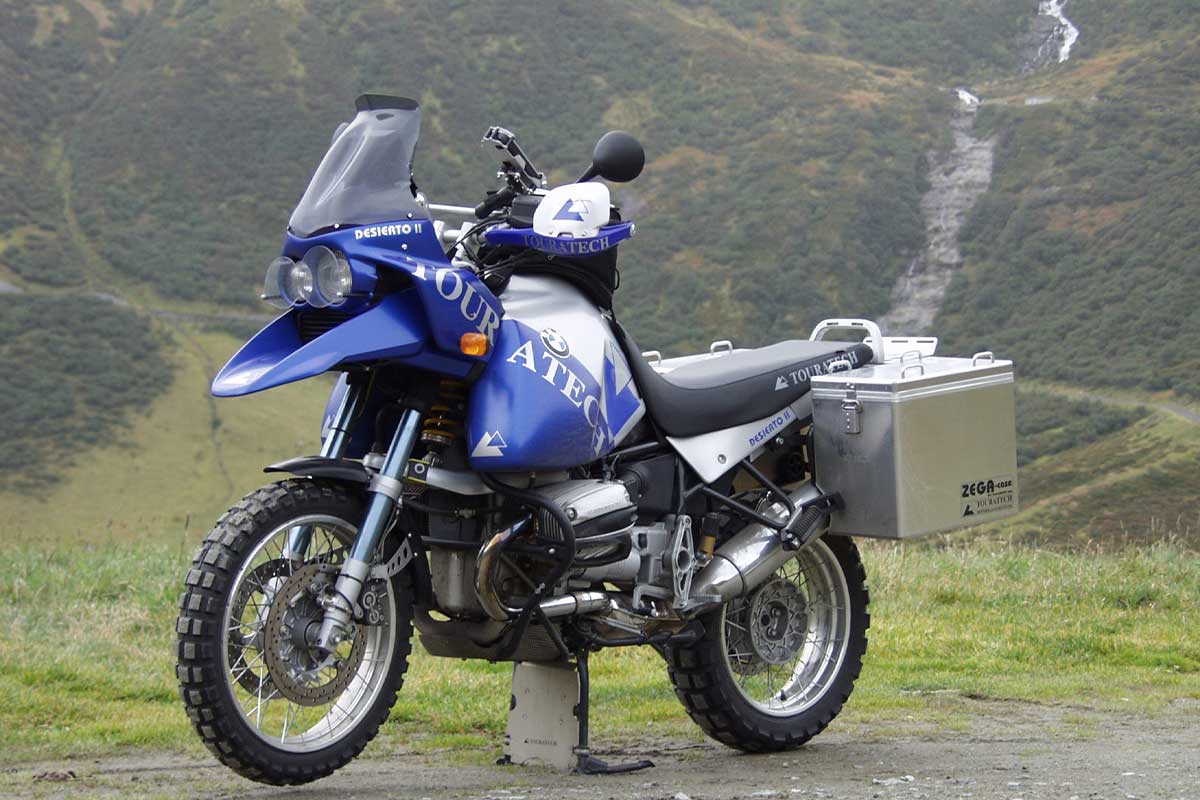
It is no secret that BMW will be adding an Adventure model to the R 1300 GS. Long-distance travellers demand increased range and maximum off-road capability. Traditionally at home in the motorbike globe-trotter scene, Touratech was already meeting this demand when BMW did not yet have an off-the-peg adventure model. While the Munich-based company provided both the R 80 G/S and the R 100 GS with the Paris-Dakar version, which was recommended for tours in poorly accessible areas thanks to a larger fuel tank and other extras, the switch to the four-valve model meant that there was no corresponding offer.
In 1998, Touratech filled this gap with the Desierto I. With a frame-mounted fairing, 21-inch front wheel, high-quality suspension elements, an offroad track-proof luggage system and, last but not least, a 41-litre tank with a long range, this machine was made for demanding long-distance journeys.
The positive response from the scene encouraged Touratech to transfer the successful concept to the following GS generations. The Desierto II based on the R 1150 GS followed in 2002, followed three years later by the Desierto III, which was based on the R 1200 GS.
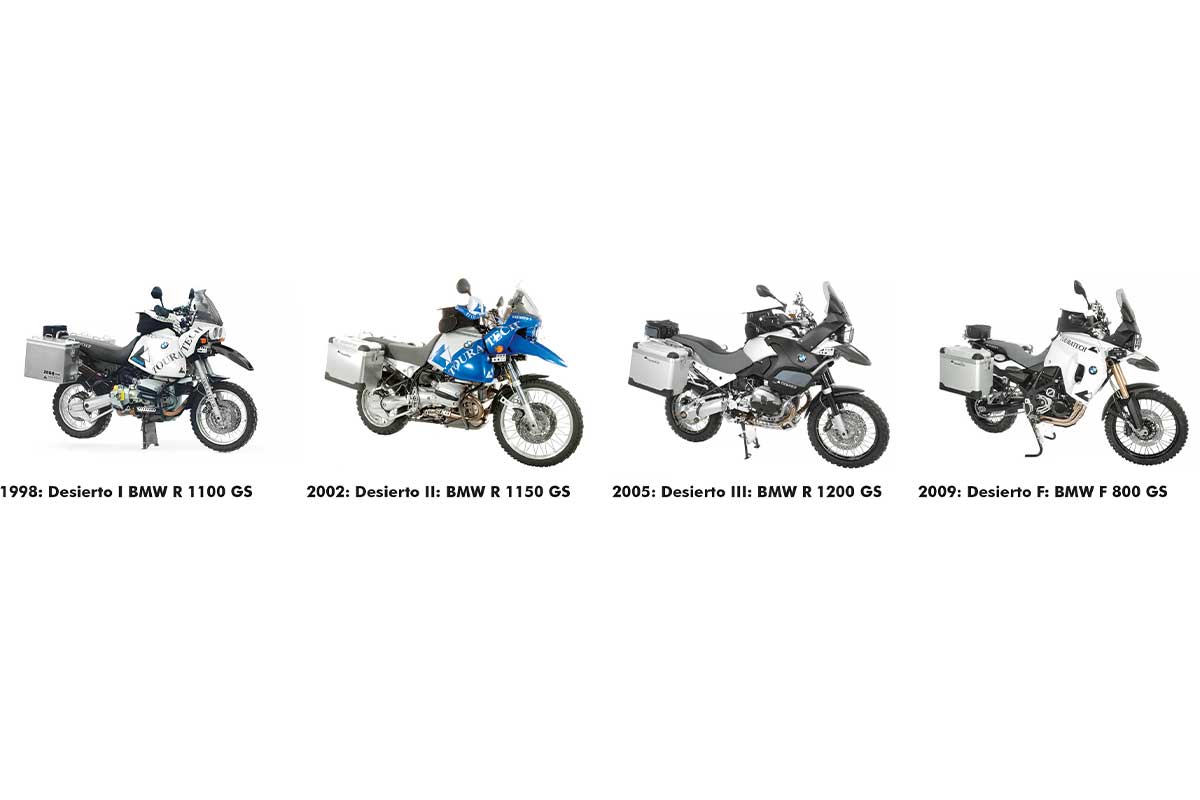
From 1999, Touratech channelled its extensive expertise in vehicle construction into a very special project: participation in the Dakar Rally. Touratech built the F 650 Rallye for the legendary desert race - the only fuel-injected rally machine at the time. At the 2001 Dakar Rally, Didier Py reached Lac Rosé at the gates of Dakar with the Touratech F 650 Rallye. The following year, Touratech sent its own works team into the desert with riders Michael Griep, Francois Flick, Didier Py, Frederic Moncassin and Gilles Algay. Algay finished 26th overall, Griep finished 29th.
The TT39, a modified F 650 GS with long-stroke suspension elements and the eponymous 39-litre tank, was created as a commercial offshoot of the Dakar project and is the perfect bike for long-distance journeys with a high proportion of off-road riding and long stages without supply options.
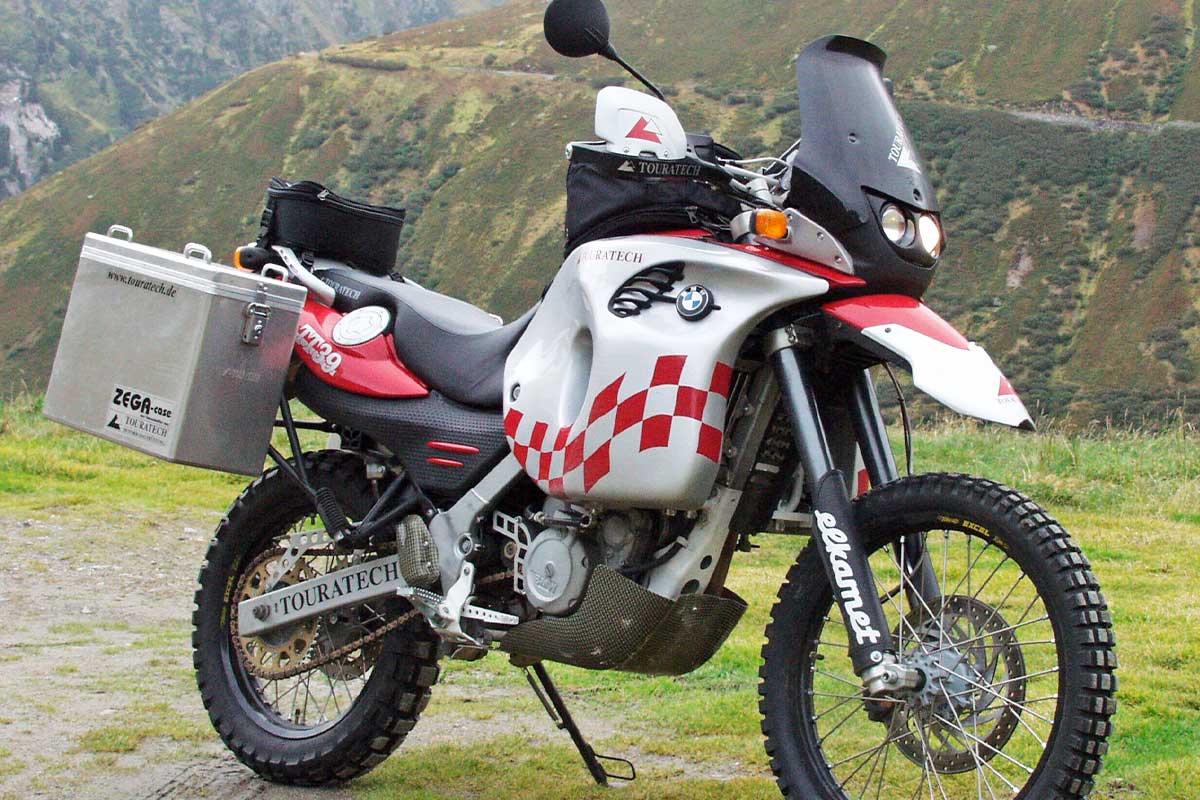
The TT39 long-distance motorbike was a direct descendant of the Touratech F 650 Rallye Dakar machine.
Numerous other conversion projects based on machines as diverse as the BMW G 450 X, the Husqvarna Nuda or the Suzuki DL650 V-Strom were realised, but the focus always remained on the boxer models. In 2013, the R 1200 Rallye prototype was created on the basis of the liquid-cooled 1200.
An extraordinary demo bike was the R9X rally boxer based on the R nineT, which Gerhard Forster rode to 14th place overall in the Iron Class at the 2017 Red Bull Romaniacs against ultra-light sports enduros. With the R 1200 GS Rambler, Touratech once again demonstrated the incredible off-road potential of the GS concept in 2017.
This also applies to the R 1250 GS RR with 21-inch front wheel and fully electronic suspension from Touratech Suspension. The machine, which was developed together with Dirk von Zitzewitz, passed its acid test at the Transitalia Marathon 2022.
After this little excursion into the world of Touratech conversions, we come back to the starting point of our considerations: When will BMW launch the Adventure based on the BMW R 1300 GS? Not that the Touratech developers have to start their own project...

MAIN FRAME MADE OF WELDED SHEET METAL PARTS
However, the innovative drive of the Munich engineers is far from exhausted with these innovations. Since the R 1200 GS, a tubular steel trellis frame has characterised the appearance of the boxer GS. This it not the case with the R 1300 GS. The filigree construction gives way to a structure made of welded pressed sheet metal parts. BMW says that this solution should be more compact, lighter and stiffer. The familiar rear frame also has to make way for a compact component made of die-cast aluminium.
ENRIQUE ALVAREZ: »LONG LIVE THE QUEEN!«
As a member of the GS Trophy Team Germany 2022, Enrique Alvarez knows the R 1250 GS inside out. BMW motorbike dealer Block am Ring in Braunschweig provided him with an R 1300 GS for his first test ride. Here are Enrique's impressions.
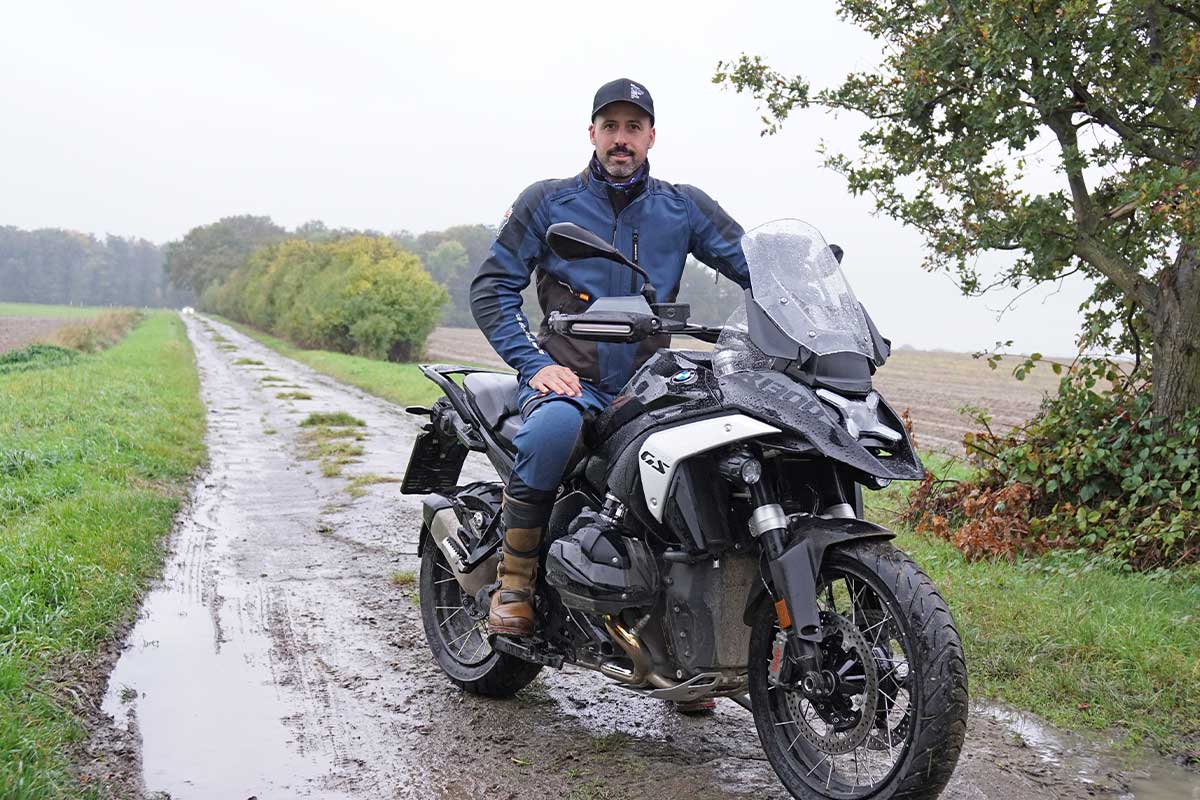
"We are already used to radical changes from BMW when it comes to model changes. However, the leap in development from the 1250 to the R 1300 GS is enormous, even by BMW standards. But as soon as you sit on the bike, you immediately get that unmistakable GS feeling, and after just a few bends you have complete confidence in the bike. You no longer sit as low behind the cockpit as on the 1250, but more on the motorbike. You also have the feeling that the motorbike has become somewhat more compact or smaller.
The display offers numerous additional options, and all assistance systems can still be configured via the touchscreen.
When starting up, the R 1300 GS sounds a little quieter than the previous model, but the boxer character is still unmistakable. The new shift assistant is finer and more precise than the last generation. This is perfect for brisk rides on winding country roads, where the revised chassis shines with additional agility.
The first ride on the R 1300 GS convinced me, and now I'm already looking forward to the opportunity to ride the GS off-road. Based on my riding impressions so far, I'm sure that the 1300 will also cut a fine figure off-road and will continue to dominate the premier class of touring enduros in the future."
GENERATION EVO: PARALEVER UND TELELEVER

The wheel suspension of the BMW R 1300 GS has been thoroughly further developed. To emphasise this, both assemblies now bear the name suffix Evo. But what does this mean in detail? The cardan shaft has been equipped with larger universal joints, and a smaller deflection angle reduces the non-uniformity of the rotational transmission typical of cardan joints. The rear axle gearbox now has a longer wheel shaft stub for easier installation and removal of the rear wheel.
In order to minimise the tilting movements of the front wheel suspension caused by the principle of the Telelever EVO, the BMW developers have reached deep into their bag of tricks. The upper triple clamp is now pivoted to the frame via a deep groove ball bearing. The swivelling connection to the fork legs is made via a flexible bearing with barrel bearings. This decoupling frees the handlebars clamped to the fork bridge from the tilting movement and ensures that the handlebars move unaffected by the suspension.
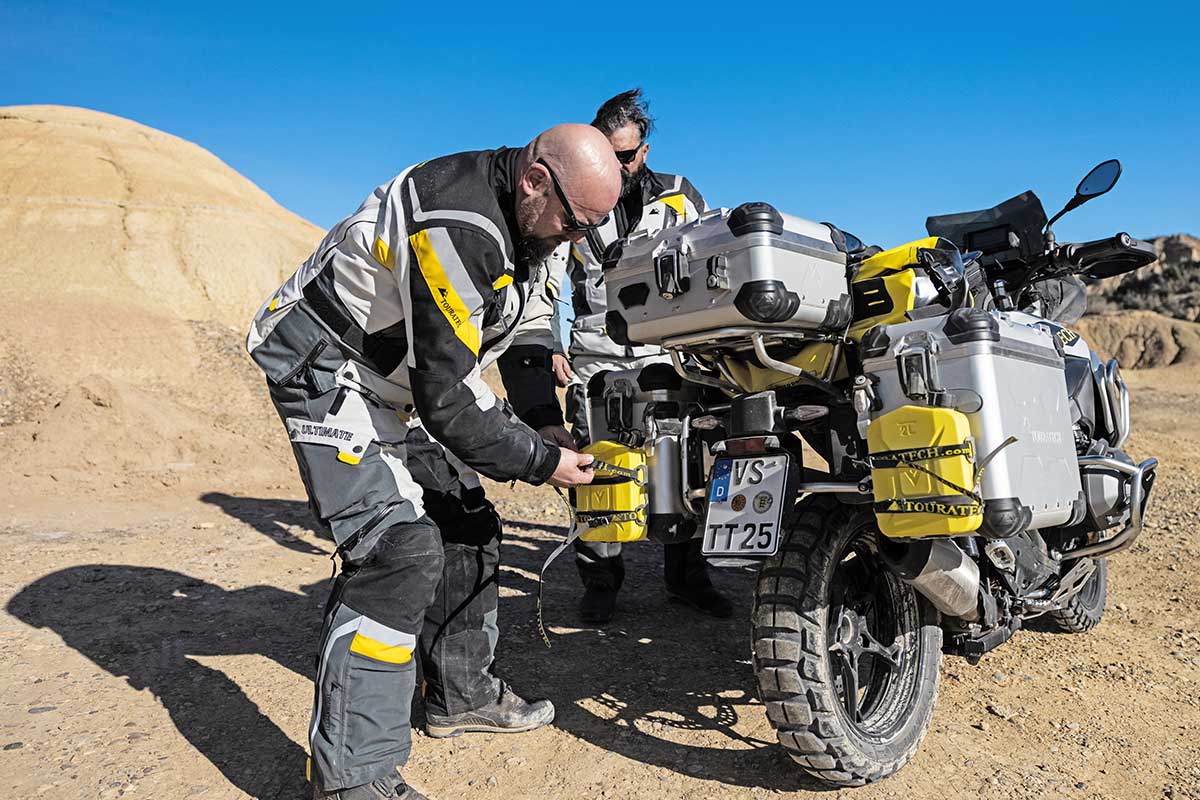
Even before the official sales launch of the R 1300 GS, Touratech has plenty of accessories available. One highlight is the symmetrical ZEGA pannier system.
RADAR-BASED ASSISTANTS
The radar equipment allows the use of advanced assistance systems (Advanced Rider Assistance Systems, ARAS for short) on board the R 1300 GS. Even in its basic configuration, the new GS is equipped with Dynamic Cruise Control (DCC) with braking function. Those who want even more safety can purchase the Riding Assistant with Active Cruise Control (ACC), Front Collision Warning (FCW) and Lane Change Warning (SWW) as optional extras ex works.

On gravel tracks, the high-modern technology of the R 1300 GS, such as the LED headlights, needs to be protected by ultra-robust protectors.

LED MATRIX HEADLIGHTS AND 6.5-INCH TFT DISPLAY
While we're on the subject of electronics: BMW has also opted for state-of-the-art technology for the lighting system on the R 1300 GS. The face of the new GS is characterised by a matrix headlight with four elements in a striking X arrangement. Naturally, all other light sources are also LED. A full-colour TFT display serves as the information centre in the cockpit, which can be customised with numerous display options and can be linked to a smartphone for additional functions.
COMPLETELY NEW AND STILL A GS
The bottom line is that the R 1300 GS is a completely new motorbike. However, BMW has once again succeeded in retaining the basic concept of both the Boxer and the GS by utilising the latest technologies.
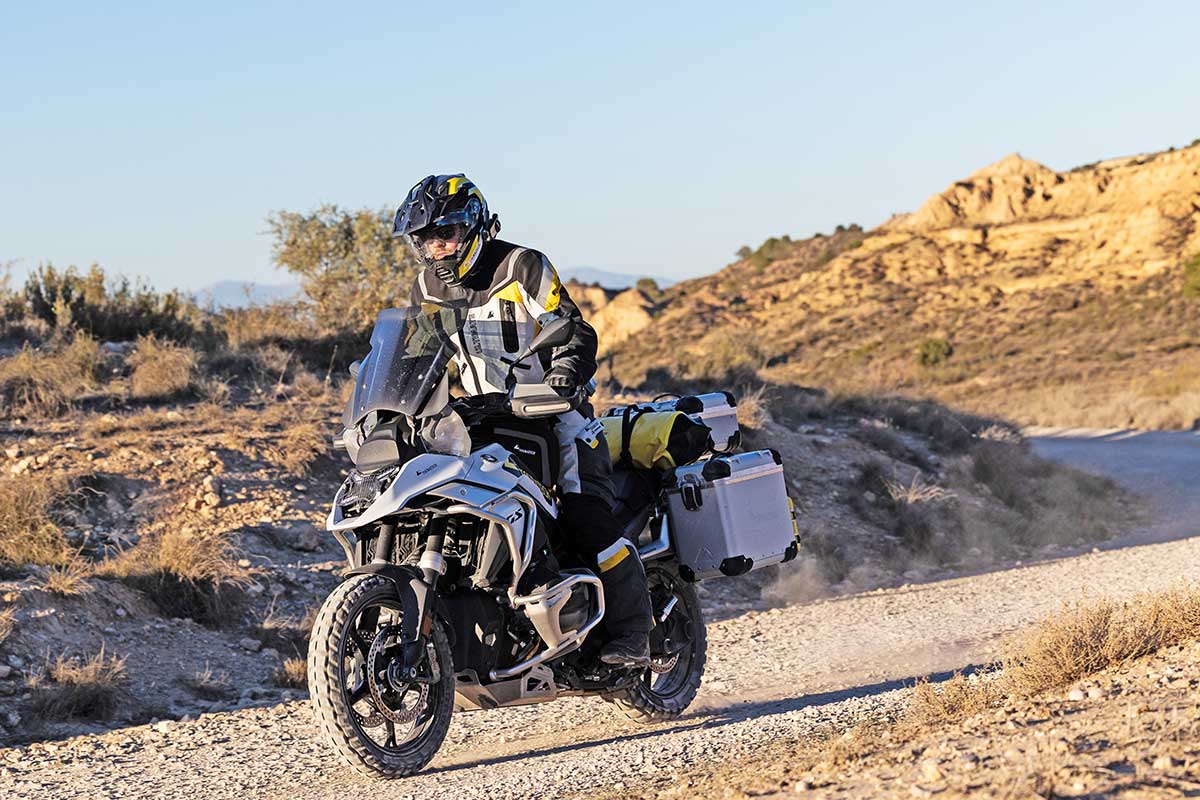
TOURATECH PARTS FOR THE BMW R 1300 GS
Numerous Touratech accessory products for the new BMW R 1300 GS are already available - and the range is growing rapidly.
All Products for the BMW R 1300 GS












